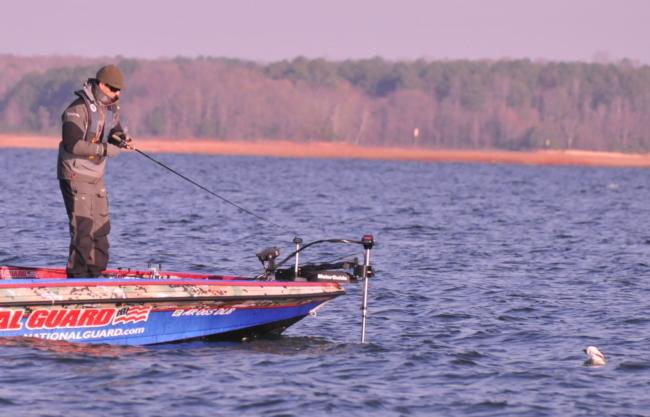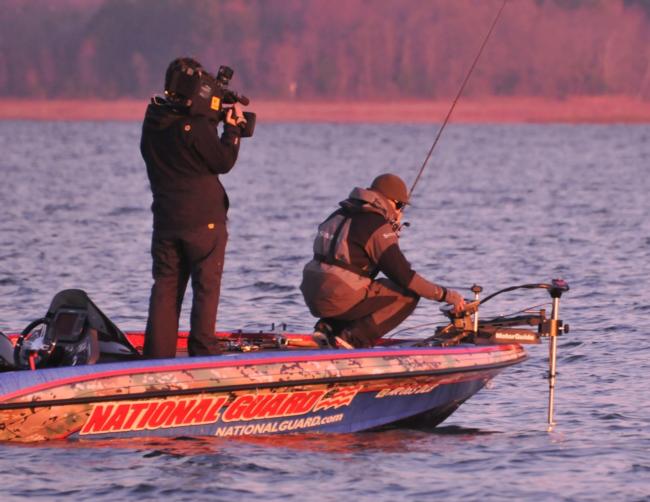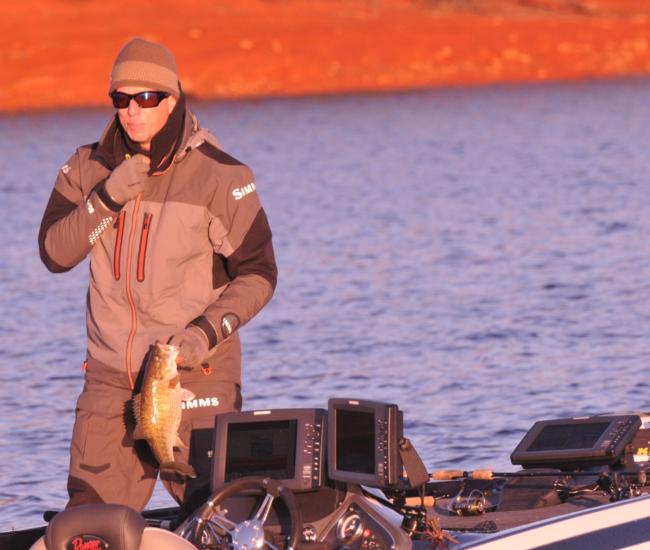Ehrler erased
Top FLW Tour pro starts each new season with the delete button

I can still remember the very words that threw a large monkey wrench into the wobbly wheels of my fishing brain:
“No, I erase all my waypoints after each tournament.”
That sentence was the response to a question I asked Brent Ehrler following his FLW Tour win on Lake Hartwell in 2012. Just the year before, Ehrler had finished second at Hartwell, so I only assumed he fished some of the same water as the previous year.
“No, I fished totally different water this year,” he clarified. “I don’t even have any of the waypoints where I finished second last year in my unit. I erase my waypoints after each tournament and at the beginning of a new season. I do that on purpose. I want to start with a clean slate.”
Erase waypoints? Clean slate? What?
Knowing the FLW Tour often repeats lakes, why in the world would Ehrler erase his waypoints? Especially after a successful tournament?
Hence, the monkey wrench. Personally, I was mystified. I thought the whole idea of this professional fishing gig was to accumulate a GPS unit full of waypoints of secret brush piles, rock piles and stump rows that held bunches of bass.
After all, isn’t that what all the finger pointing is about after big tournaments? So and so got waypoints from such and such…and so on and so forth. I thought these coveted waypoints were the numeric keys to the professional fishing kingdom.
Well, apparently not for Ehrler, who is turning tournament fishing convention upside down with his waypoint erasing ways.
Perils of a plotted past
“Don’t get me wrong, waypoints are certainly a critical part of fishing,” Ehrler began. “I do use and accumulate waypoints during the week of a tournament, but once it’s over, I erase them all.”
“My idea of bass fishing is not to run a bunch of waypoints from last year, or a bunch of waypoints someone gave me,” he continued. “I’ve tried that formula before and it doesn’t work for me. I find it leads to a lot of wasted time and disappointment.”
To hear him talk, one starts to get the idea that Ehrler might actually push the delete button on all the fishing information in his brain if he could.
“It’s only human nature to want to go back to where you have caught fish before,” Ehrler reasoned. “But we’ve reached the point in this sport where things change so fast that chasing the memories of past tournaments is a bad habit.”
Ehrler’s thrill in bass fishing comes from finding new fish on new water. He prefers fishing on a completely visceral level, where decisions come primarily from feel and are not corrupted by preconceived notions or predetermined scripts.
 New water is so pure because there are no previous judgments about what’s good or bad,” he continued. “On new water, I feel my way through an area with a lot of different baits and an open mind, giving the fish a lot of opportunities to show me what they are up to at that instance. But when I pull into a familiar place where I’ve had success before, the memories want me to repeat the same exact steps that produced last time and that hardly ever works because conditions and fish can change so fast.”
New water is so pure because there are no previous judgments about what’s good or bad,” he continued. “On new water, I feel my way through an area with a lot of different baits and an open mind, giving the fish a lot of opportunities to show me what they are up to at that instance. But when I pull into a familiar place where I’ve had success before, the memories want me to repeat the same exact steps that produced last time and that hardly ever works because conditions and fish can change so fast.”
In fact, when Ehrler gets a bite or two during practice, he often leaves the area immediately to avoid discovering too much, too early. Sometimes he never even makes a cast on a spot. He will just put a waypoint on a place that “looks good” and continue on.
“The ultimate goal for me is to figure the fish out during the actual tournament hours, not three days before hand,” he explains. “In my opinion, fish change too fast to `dial them in’ three days before a tournament.”
Practice makes permanence
Ehrler’s approach to professional fishing today is somewhat different than what was standard 20 years ago. Back then the object was to locate productive areas and really refine patterns in practice in hopes the fish stayed true to those same exact areas and patterns come tournament time.
But from Ehrler’s perspective, learning too much in practice is almost a detriment to the process because the second you catch a fish you begin to lay down a permanent record of how the fish were positioned and what they were biting. That concrete knowledge can often push real-time intuition out of the nest come tournament time when things have changed.
One example Ehrler provides of this phenomenon is when co-anglers catch big bags behind pros. Pros head to an area with a deliberate purpose and plan, based on practice. The co-anger, however, is seeing the area for the first time – it’s all new water to him – and he throws what feels right to him at the time.
“Pretty soon the co-angler is smashing them and the pro is still attached to what was working in practice,” Ehrler suggested. “It’s a real eye opener on just how fast fish can change from day to day.”
At times it’s almost as if Ehrler views the timing of the underworld on a more microscopic level. Instead of seeing fish patterns on broad timetables of days or weeks, he sees their behaviors in much smaller increments – like by the hour or even minutes. And staying open to those extremely subtle opportunities during a tournament day means not being too attached to the past.
And so it stands: Ehrler’s standards for freshness in fishing are so steep it’s understandable why he considers year-old waypoints hanging around in his units as being rotten.
“It’s so hard keeping a fresh perspective on lakes you have visited multiple times, the memories and previous knowledge nag at you,” Ehrler said. “But how many times are tournaments won on the same spot the next time? Hardly ever. Lakes change. Weather changes. The forage base shifts. Fishing pressure gets applied. Bass are always in flux, adapting to their environment.”
But what if Ehrler did want to go back to fish a productive spot from years past? Wouldn’t it be easier to have the waypoint already in the unit?
“My favorite part of fishing is the discovery process,” Ehrler reveals. “Waypoints take away that process to some degree because it just becomes a routine of rolling up to GPS points and casting at them. Even if I’m going to revisit a spot from the past, I like to start from scratch and sort of discover it again.”
Ehrler has actually found some of his best spots while looking for previous spots.
“I’ll find another little turn or corner that I did not even know was there the last time I fished it,” he says. “Forcing myself to re-find the old spot is the only way I can see it with fresh eyes.”
Floating around on the meter
Despite having little use for old waypoints, Ehrler does rely heavily on today’s on-board, big-screen super computers to find fish in real-time. The latest fish finding technology is so powerful it has bridged the gap between finding likely spots that might hold fish to finding the actual fish.
And that’s a concept Ehrler takes advantage of. He is a whiz at deciphering what his Humminbird units are telling him at any given moment. He maximizes the full potential of his units by running traditional sonar, zoom sonar, side imaging and down imaging. And despite all the incredible functions these high-end electronics perform, Ehrler still refers to his depthfinder simply as a “meter.”
“With today’s super definition, target separation and different views of the water column, identifying bass on the fly has become much easier,” Ehrler remarked. “It’s not like, well I think it’s bass in that brush pile, or I think those are fish on the bottom – it’s pretty definitive.”
Having that kind of confidence in his electronics allows Ehrler to, “fish off his meter” or “float around on his meter,” during tournament hours looking for bass in real-time on his electronics instead of relying on waypoints where bass used to be.
“You can only waypoint places, not bass,” Ehrler pointed out. “They’re not always one and the same. If the bass move, the waypoint becomes just a place marker of the past. But meters don’t lie; they mark fish in real time.”
Ehrler’s ability to find fish on the fly with his meters is impressive. He rides with his boat just on plane, scanning vast areas of the lake.
When something catches his attention, he scours it closer at an idle with multiple views of the underwater world simultaneously scrolling across multiple screens. He is constantly zooming in on images or sliding a cursor across the screen to create waypoints on specific objects or even specific fish for momentary references. Then he jumps to the bow, grabs a rod, juices up the sonar, finds a fish “on the meter” and then proceeds to drop a lure to it to see “what kind of mood it’s in.”
“When I find a new group of fish like that during a tournament day, it’s the ultimate thrill in tournament fishing,” Ehrler said. “I know they’re untouched and there is not a line of people waiting to cast at them. Even when I know that potential exists to find a group like that in a tournament, I can’t wait to get out of bed and go out there looking for them.”
In particular, Ehrler’s resume on highland-type impoundments with clear water and mixed bass species is stellar.
Consider his FLW Outdoors wins on places like Lake Cumberland, Logan Martin, Shasta, Havasu, Table Rock, Ouachita and Hartwell. In addition, Ehrler won the inaugural Major League Fishing event on Lake Amistad, a fishing competition specifically designed around no practice and no waypoints – Ehrler’s briar patch.
All of Ehrler’s wins have consistent themes: No use of previous waypoints, limited attachment to practice, fishing on the fly, fishing new water, finding new fish and staying open to new micro patterns that might be emerging during the day. Actually, it’s quite a breath of fresh air in a waypoint weary sport.
“The hard part in this sport is making new water out of old water you have already fished at one time or another. And that’s really what I’m trying to accomplish in erasing waypoints: I’m trying to see the lake as new body of water again.”